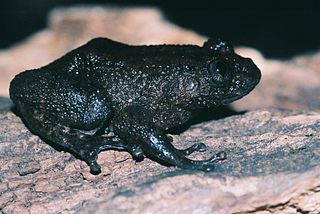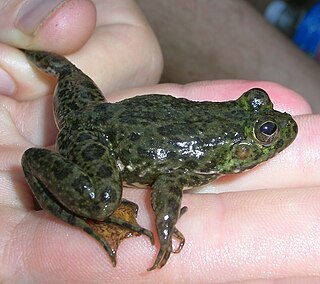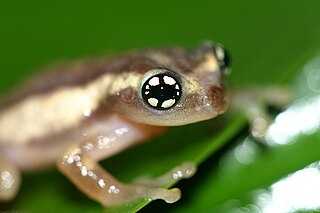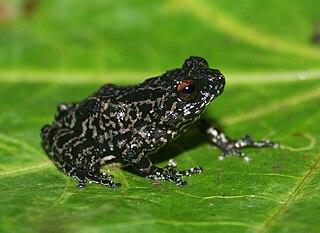
Microhyla sholigari is a species of microhylid frog endemic to southern India. It was described from the Biligirirangan Hills in Chamarajanagar district, Karnataka and is named after the Soliga tribal people living in the forests in and around these hills. The frog was thought to be endemic to the Western Ghats and known only from the type locality and another location in Kerala and was listed as an Endangered species. A recent study reported the species from 15 localities in the central Western Ghats with individuals sighted near the Bannerghatta National Park, Bangalore, Karnataka. The study supplemented the original species description with color photographs, call recordings and provided a re-assessment of the threat status as per the IUCN Red List and suggest the status as Least-concern species because the criteria for classifying it as an endangered species are no longer fulfilled.
Mount Duida frogs (Dischidodactylus), is a genus of craugastorid frogs endemic to the tepuis of southern Venezuela. The scientific name is derived from the Greek dischidos, meaning divided, and dactylos, meaning finger or toe, in reference to the divided ungual flap.

Nyctibatrachus is a genus of frogs endemic to the Western Ghats of southwestern India. Their common name is night frogs. Their scientific name also means "night frog", in reference to their habits and dark color. They are the only extant members of the monotypic subfamily Nyctibatrachinae. Currently, 35 species belong to Nyctibatrachus.

Euphlyctis is a genus of frogs in family Dicroglossidae distributed from the southwestern Arabian Peninsula, Pakistan and Afghanistan to India, Nepal, through Myanmar and Thailand to Malaya, and Sri Lanka. None of the four species assessed by the IUCN is considered threatened.

Microhyla, commonly known as the rice frogs or narrow-mouthed frogs, is a genus of frogs in the family Microhylidae. It consists of 42 species of diminutive frogs. Members of this genus are widespread from Ryukyu Is. in Japan, and throughout South-east Asia,.

Micrixalus fuscus is a species of small frog found in dense forested hill streams in the Western Ghats of India. M. herrei was formerly synonymized within this species.
Scutiger mammatus is a species of frog in the family Megophryidae. It is endemic to Western China and known from eastern Tibet, southeastern Qinghai, western Sichuan, and northwestern Yunnan.
Microhyla borneensis, also known as the Matang narrow-mouthed frog, is a species of microhylid frog found in the Matang Range in Sarawak, Borneo. It was once the smallest known frog from the Old World. Adult males of this species have a snout-vent length (SVL) of 10.6–12.8 mm (0.42–0.50 in), but adult males can reach a maximum of 13 mm (0.51 in),and adult females of this species have a snout-vent length of 16–19 mm (0.63–0.75 in), Tadpoles measure just 3 mm.

Nannophrys guentheri is an extinct species of frog in the family Dicroglossidae. It was endemic to Sri Lanka. The species was first identified in 1882 by George Boulenger and named after the German-born British zoologist Albert Günther. It is not known where in Sri Lanka the specimens were found.
Nanorana rarica is a frog species in the family Dicroglossidae. It is endemic to western Nepal. Its type locality is the eponymous Rara Lake located in the Rara National Park.

Raorchestes ochlandrae is a species of shrub frog in the family Rhacophoridae. It is endemic to the Western Ghats, India. This species of the oriental shrub frog was first described from Kakkayam Reserve Forest of Calicut district, Kerala state, in the southern Western Ghats in 2007 but has since been recorded at many other sites along the Western Ghats. The specific name ochlandrae refers to microhabitat of the species, bamboo Ochlandra setigera.

Raorchestes is a genus of frogs in the subfamily Rhacophorinae that are found in mountainous regions of South Asia, Southeast Asia, and southern China. A recent study places Raorchestes as a sister taxon of Pseudophilautus. Before the description of the genus in 2010, species now in Raorchestes had been assigned to genera Ixalus, Philautus, and Pseudophilautus.

Raorchestes kakachi is a species of frogs in the family Rhacophoridae. It is endemic to the southern Western Ghats of India. The specific name kakachi refers to the type locality from where the species was described.

Raorchestes ghatei is a species of shrub frogs from the Western Ghats of Maharashtra.

Microhyla laterite or laterite narrow-mouthed frog is a species of frog discovered in Karnataka, India in 2016. It is known from ephemeral ponds forming in laterite soil along the coastal fringe adjoining the Karnataka Western Ghats.

Raorchestes honnametti is a species of frog in the family Rhacophoridae that is described from the Biligiri Rangaswamy Tiger Reserve in Karnataka.
Occidozyga tompotika is a species of frog in the family Dicroglossidae. It is endemic to Sulawesi, Indonesia, where it is known from the Balantak Mountains in the Central Sulawesi Province. It is named after Mount Tompotika, its type locality.

Psychrophrynella chirihampatu is a species of frogs in the family Craugastoridae. It is endemic to Peru and only known from its type locality, Japumato Valley in the Peruvian Andes in the Cusco. Common names Japumayo Andes frog has been coined for this species.

Euphlyctis aloysii is a species of frog in the family Dicroglossidae. It is endemic to Karnataka, southwestern India. It was described from a female holotype from Mangalore, Karnataka.















